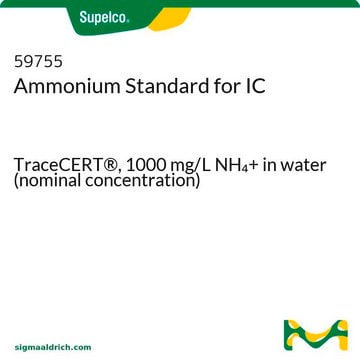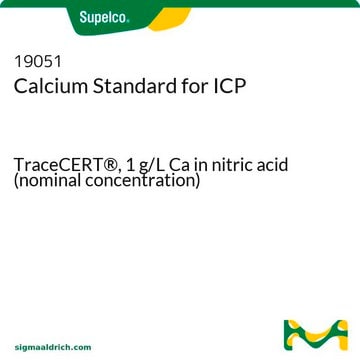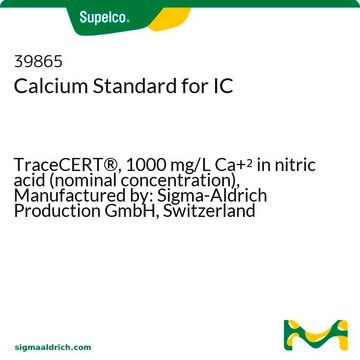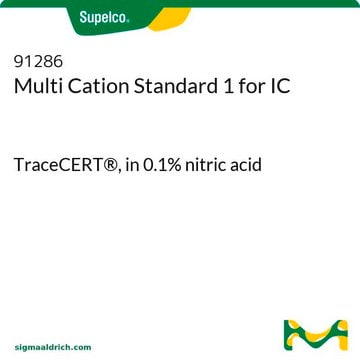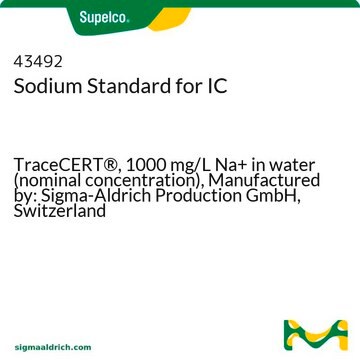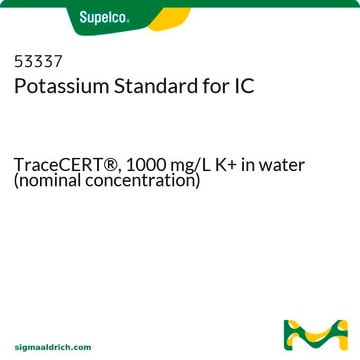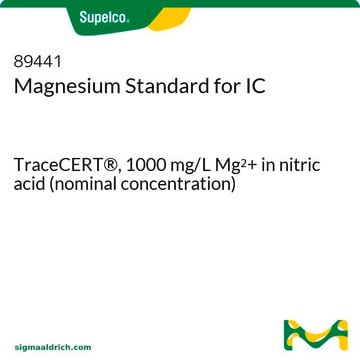55517
Methanesulfonic acid concentrate
0.1 M CH3SO3H in water (0.1N), eluent concentrate for IC
Synonym(s):
Methanesulfonic acid solution
Sign Into View Organizational & Contract Pricing
All Photos(1)
About This Item
Linear Formula:
CH3SO3H
CAS Number:
Molecular Weight:
96.11
Beilstein:
1446024
MDL number:
UNSPSC Code:
12161700
PubChem Substance ID:
NACRES:
NB.21
Recommended Products
Quality Level
concentration
0.1 M CH3SO3H in water (0.1N)
technique(s)
ion chromatography: suitable
SMILES string
CS(O)(=O)=O
InChI
1S/CH4O3S/c1-5(2,3)4/h1H3,(H,2,3,4)
InChI key
AFVFQIVMOAPDHO-UHFFFAOYSA-N
Looking for similar products? Visit Product Comparison Guide
General description
This eluent concentrate for ion chromatography is determined by potentiometric titration. Content and expiry date can be found on the certificate.
Application
- Design of a new nanocomposite based on Keggin-type [ZnW(12)O(40)](6-) anionic cluster anchored on NiZn(2)O(4) ceramics: Explores the synthesis of advanced materials using Methanesulfonic acid, contributing to developments in energy storage and catalysis technology (Rezvani et al., 2024).
- Nanosuspensions in ophthalmology: Overcoming challenges and enhancing drug delivery for eye diseases: Discusses the role of Methanesulfonic acid in the formulation of nanosuspensions, enhancing therapeutic efficiency in ophthalmologic applications (Fathi-Karkan et al., 2024).
- Building Flame-Retardant Polymer Electrolytes via Microcapsule Technology for Stable Lithium Batteries: Methanesulfonic acid may be utilized in the synthesis of flame-retardant materials for safer lithium battery technologies, addressing critical needs in electronic manufacturing (Zhang et al., 2024).
- Catalysts for C-N coupling in urea electrosynthesis under ambient conditions from carbon dioxide and nitrogenous species: Highlights the application of Methanesulfonic acid in developing catalysts for green chemistry processes, particularly in the efficient synthesis of urea from environmentally benign sources (Yang et al., 2024).
Linkage
Visit the IC Portal to learn more
Preparation Note
Prepared with methanesulfonic acid and high purity water (18.2 MΩ, 0.2 μm filtered)
related product
Product No.
Description
Pricing
Storage Class Code
12 - Non Combustible Liquids
WGK
nwg
Flash Point(F)
Not applicable
Flash Point(C)
Not applicable
Personal Protective Equipment
dust mask type N95 (US), Eyeshields, Gloves
Choose from one of the most recent versions:
Already Own This Product?
Find documentation for the products that you have recently purchased in the Document Library.
Customers Also Viewed
Neal W Sach et al.
Organic letters, 14(15), 3886-3889 (2012-07-18)
A general synthesis of aryl ethers from primary and secondary alcohols and aryl mesylates is presented. The reaction proceeds via a sulfonyl-transfer mechanism. In this paper, we compare the sulfonyl transfer reaction to Mitsunobu ether formation. The reaction can be
Renata Solarska et al.
Nanoscale, 4(5), 1553-1556 (2012-02-01)
Nanostructuring of semiconductor films offers the potential means for producing photoelectrodes with improved minority charge carrier collection. Crucial to the effective operation of the photoelectrode is also the choice of a suitable electrolyte. The behaviour of the nanostructured WO(3) photoanodes
Cassandra J Gaston et al.
Environmental science & technology, 44(5), 1566-1572 (2010-02-04)
Dimethyl sulfide (DMS), produced by oceanic phytoplankton, is oxidized to form methanesulfonic acid (MSA) and sulfate, which influence particle chemistry and hygroscopicity. Unlike sulfate, MSA has no known anthropogenic source making it a useful tracer for ocean-derived biogenic sulfur. Despite
Chris Twelves et al.
Breast cancer research and treatment, 148(3), 553-561 (2014-11-09)
Data from two phase 3 studies of eribulin were pooled in analyses initially requested by the European Medicines Agency to assess whether specific patient subgroups, previously treated with an anthracycline and a taxane, benefited from eribulin. Study 305/EMBRACE included women
Eric D Nacsa et al.
Organic letters, 15(1), 38-41 (2012-12-15)
The cyclopropenone catalyzed nucleophilic substitution of alcohols by methanesulfonate ion with inversion of configuration is described. This work provides an alternative to the Mitsunobu reaction that avoids the use of azodicarboxylates and generation of hydrazine and phosphine oxide byproducts. This
Our team of scientists has experience in all areas of research including Life Science, Material Science, Chemical Synthesis, Chromatography, Analytical and many others.
Contact Technical Service
